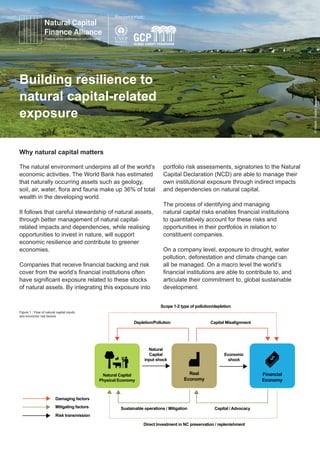More Related Content
Similar to NCFA_SECO_print
Similar to NCFA_SECO_print (20)
NCFA_SECO_print
- 1. Why natural capital matters
The natural environment underpins all of the world’s
economic activities. The World Bank has estimated
that naturally occurring assets such as geology,
soil, air, water, flora and fauna make up 36% of total
wealth in the developing world.
It follows that careful stewardship of natural assets,
through better management of natural capital-
related impacts and dependencies, while realising
opportunities to invest in nature, will support
economic resilience and contribute to greener
economies.
Companies that receive financial backing and risk
cover from the world’s financial institutions often
have significant exposure related to these stocks
of natural assets. By integrating this exposure into
portfolio risk assessments, signatories to the Natural
Capital Declaration (NCD) are able to manage their
own institutional exposure through indirect impacts
and dependencies on natural capital.
The process of identifying and managing
natural capital risks enables financial institutions
to quantitatively account for these risks and
opportunities in their portfolios in relation to
constituent companies.
On a company level, exposure to drought, water
pollution, deforestation and climate change can
all be managed. On a macro level the world’s
financial institutions are able to contribute to, and
articulate their commitment to, global sustainable
development.
Building resilience to
natural capital-related
exposure
Natural Capital
Physical Economy
Real
Economy
Financial
Economy
Depletion/Pollution Capital Misalignment
Scope 1-2 type of pollution/depletion
Sustainable operations / Mitigation Capital / Advocacy
Direct Investment in NC preservation / replenishment
Natural
Capital
input shock
Economic
shock
Damaging factors
Mitigating factors
Risk transmission
Figure 1 : Flow of natural capital inputs
and economic risk factors ©iStock:LesleyJacques
- 2. About the Advancing Environmental
Management Project (AERM)
Natural Capital Declaration projects such as the
Advancing Environmental Risk Management (AERM)
project aims to benefit from the collective expertise
of the NCD’s 40+ financial signatories, as well as
supporting organisations, to develop approaches to
risk management that are customised for different
sectors and regions.
The project has received significant support from
the Swiss State Secretariat for Economic Affairs
(SECO), the MAVA foundation and participating
financial institutions. SECO is already supporting the
Natural Capital Agenda at government level through
Wealth Accounting and the Valuation of Ecosystems
(WAVES) and at the company level through the
Natural Capital Coalition.
The methodology for mapping natural capital
The aim of this NCD-backed project is to support
financial institutions in the process of embedding
natural capital-related risks within risk assessment
methods and decision-making tools.
In phase 1, NCD will collect relevant natural capital
data from each location that can be linked to an
inventory of economic activities. The phase 1 natural
capital and economic risk data will form the basis for
systematic risk analysis globally, with specific attention
to Colombia, Indonesia, South Africa and Peru.
This data will form the foundation for phase 2, in which
specific risk assessment methodologies and tools
will be developed to assess the economic impacts
of specific natural capital risks and to embed the
systematic consideration of these risks within existing
risk assessment and other investment decision-making
tools.
The phase 2 economic impact and resilience
assessment for integration into credit risk will be tested
in sectors, regions and asset classes defined by the
financial institutions that are part of the project.
As a result of this project, financial institutions will work
towards quantifying and incorporating natural capital
risks into lending and investment decisions, signalling
a significant breakthrough in risk management
practices. This work will also be critical in helping
financial institutions better support and help realise
climate and sustainable development commitments.
Get involved
Financial institutions are integral to the world’s
economies and as such have tremendous
influence on economic outcomes. By
becoming a signatory to the NCD you will
contribute to understanding natural capital-
related impacts and dependencies for the
finance sector, thereby building the business
case for developing more resilient business
models and contributing to the world’s
transition to a greener economy. Find out how
to become a member of the NCD and/or get
involved with the AERM project here.
© iStock : Sasha Radosavljevic
© iStock : Herianus
www.naturalcapitaldeclaration.org/how-to-become-a-signatory
